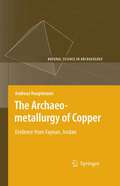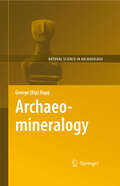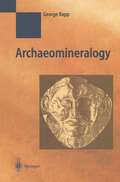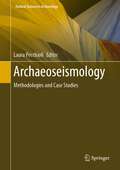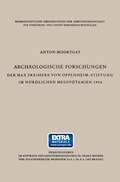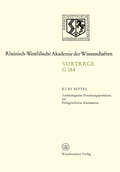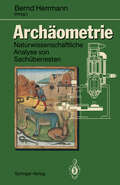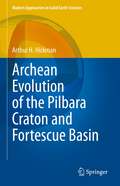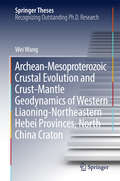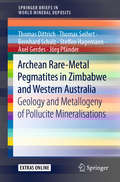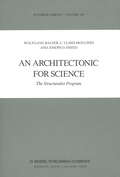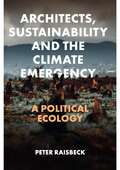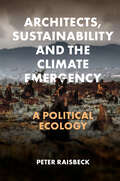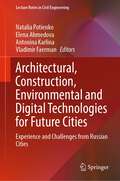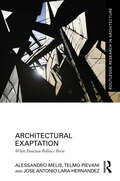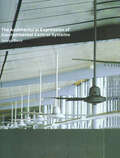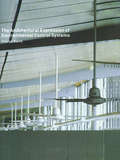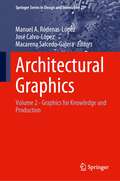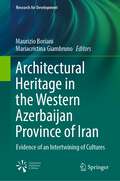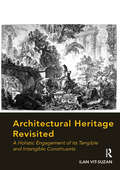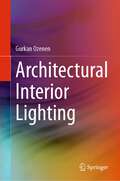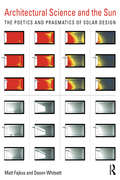- Table View
- List View
The Archaeometallurgy of Copper: Evidence from Faynan, Jordan (Natural Science in Archaeology)
by Andreas HauptmannThe book deals with the ancient exploitation and production of copper, exemplified by the mining district of Faynan, Jordan. It is an interdisciplinary study that comprises (mining-) archaeological and scientific aspects. The development of organizational patterns and technological improvements of mining and smelting through the ages (5th millennium BC to Roman Byzantine period), in a specific mining region, is discussed.
Archaeomineralogy (Natural Science in Archaeology)
by George Rapp“Archaeomineralogy” provides a wealth of information for mineralogists, geologists and archaeologists involved in archaeometric studies. The first edition was very well-received and praised for its systematic description of the rocks and minerals used throughout the world by our ancestors and for its excellent list of over 900 references, providing easy access to the fields of archaeomineralogy and geoarchaeology.This second edition of “Archaeomineralogy” takes an updated and expanded look at the human use of rocks and minerals from the Paleolithic through to the 18th century CE. It retains the structure and main themes of the original but has been revised and expanded with more than 200 new references within the text, a bibliography of additional references not included in the text, a dozen new figures (drawings and photos), coverage of many additional important mineral, rock, and gem materials, a broader geographic scope, particularly but not limited to Eastern Europe, and a more thorough review of early contributions to archaeomineralogy, especially those of Agricola. From reviews of the first edition:"… crammed full of useful information, is well-balanced using both new and Old World examples of the archaeomaterials described. It also provides a broad, but of necessity, all too brief overview of the geological raw materials used in antiquity." -- Geoscientist "…provides much interesting discussion of how particular names came to be employed by archaeologists working in different regions of the world…. much to offer for any geologist or archaeologist interested in minerals and rocks and how they have been used in the past." -- Mineralium Deposita"… a gem of a book, it's strength is that it is encyclopedic in content, if not in layout, draws on a wealth of field experience and almost every sentence contains a nugget of information" -- The Holocene
Archaeomineralogy (Natural Science in Archaeology)
by George R. Rapp1.1 Prologue What is archaeomineralogy? The term has been used at least once before (Mitchell 1985), but this volume is the first publication to lay down the scientific basis and systematics for this subdiscipline. Students sometimes call an introductory archaeology course "stones and bones." Archaeomineralogy covers the stones component of this phrase. Of course, archaeology consists of a great deal more than just stones and bones. Contemporary archaeology is based on stratigraphy, geomorphology, chronometry, behavioral inferences, and a host of additional disciplines in addition to those devoted to stones and bones. To hazard a definition: archaeomineralogy is the study of the minerals and rocks used by ancient societies over space and time, as implements, orna ments, building materials, and raw materials for ceramics and other processed products. Archaeomineralogy also attempts to date, source, or otherwise char acterize an artifact or feature, or to interpret past depositional alteration of archaeological contexts. Unlike geoarchaeology, archaeomineralogy is not, and is not likely to become, a recognized subdiscipline. Practitioners of archaeomineralogy are mostly geoarchaeologists who specialize in geology and have a strong background in mineralogy or petrology (the study of the origin ofrocks).
Archaeoseismology: Methodologies and Case Studies (Natural Science in Archaeology)
by Laura PecchioliArchaeoseismic research provides data and information on past earthquakes but is limited by the lack of ongoing discussions about methodology. This volume is an interdisciplinary approach including archaeologists, geologists, geophysicists, seismologists, engineers, and architects from different countries to present a comprehensive recording and interpretation of ancient natural disasters on some case studies. The publication is an introduction to various aspects of the field of archaeoseismology for the knowledge of past seismicity, the reconstruction of the chronological history of a place, the interpretation and identification of seismic effects using different methods, etc. The collection provides an overview of research into archaeoseismology, making new contributions through innovative ideas on various topics. The publication can be an illustrative introduction to better understand the complexity of interpreting seismic effects on ancient and modern masonries, particularly for students with an open mind.
Archäologische Forschungen der Max Freiherr von Oppenheim-Stiftung im nördlichen Mesopotamien 1956 (Wissenschaftliche Abhandlungen der Arbeitsgemeinschaft für Forschung des Landes Nordrhein-Westfalen #7)
by Anton MoortgatArchäologische Forschungsprobleme zur Frühgeschichte Kleinasiens: 168. Sitzung am 23. Juni 1971 in Düsseldorf (Rheinisch-Westfälische Akademie der Wissenschaften #184)
by Kurt BittelArchäometrie: Naturwissenschaftliche Analyse von Sachüberresten
by Bernd HerrmannNaturwissenschaftliche Methoden sind heute unverzichtbarer Bestandteil umwelthistorischer und archäologischer Forschung und ermöglichen erst viele Befunde, auf die sich weiterreichende Aussagen gründen. Solche Aussagen und Zusammenhänge stehen im Mittelpunkt der Beiträge dieses Buches. Als Einführung wie als Begleitlektüre zum Praktikum gleichermaßen geeignet, stellt es klassische Methoden der Archäometrie, wie z.B. Datierungs- und Analyseverfahren, ebenso vor wie moderne Zugänge z.B. zu alter DNA oder die Auswertung anthropologischer, botanischer und zoologischer Befunde. Dieses Konzept schließt damit jene Lücke, welche bisher in der archäometrischen Darstellung biologischer Fundstücke bestand, und ist daher einer umweltgeschichtlichen Sichtweise besonders verpflichtet.
Archean Evolution of the Pilbara Craton and Fortescue Basin (Modern Approaches in Solid Earth Sciences #24)
by Arthur H. HickmanOne of today’s major geoscientific controversies centres on the origin of the Archean granite‒greenstone terranes. Is the geology of these scattered remnants of our planet’s early crust consistent with the theory that modern-style plate-tectonic processes operated from the early Archean, or does it indicate that tectonic and magmatic processes were different in the Archean? Earth has clearly evolved since its initial formation, so at what stage did its processes of crustal growth first resemble those of today? The logical place to seek answers to these intriguing and important questions is within the best-preserved early Archean crust. The Pilbara region of northwest Australia is internationally famous for its abundant and exceptionally well-preserved fossil evidence of early life. However, until recently the area has received much less recognition for the key evidence it provides on early Archean crustal evolution. This book presents and interprets this evidence through a new stage-by-stage account of the development of the Pilbara’s geological record between 3.53 and 2.63 Ga. The Archean Pilbara crust represents one fragment of Earth’s oldest known supercontinent Vaalbara, which also included the Kaapvaal Craton of southern Africa. Recognition of Vaalbara expands the background database for both these areas, allowing us to more fully understand each of them.
Archean-Mesoproterozoic Crustal Evolution and Crust-Mantle Geodynamics of Western Liaoning-Northeastern Hebei Provinces, North China Craton (Springer Theses)
by Wei WangThis thesis presents geological, petrological, geochemical, and zircon U–Pb–Lu–Hf isotopic field data for representative Precambrian lithologies in the Western Liaoning-Northeastern Hebei Provinces along the northern margin of the North China Craton (NCC). It describes late Neoarchean (2.64–2.48 Ga) supracrustal metavolcanic rocks and granitoid gneisses; late Paleoproterozoic (1.72–1.68 Ga) Jianping alkaline plutons and Pinggu alkaline volcanic rocks; and newly discovered ~1.23 Ga mafic dykes. The nature of magma sources and genesis of each magmatic episode are investigated, and the Precambrian (~2.6–1.2 Ga) lithospheric mantle evolution and crust-mantle interaction processes are established for the first time –aspects that provide important constraints in our understanding of the Precambrian crustal evolution and geodynamic processes in the region studied.
Archean Rare-Metal Pegmatites in Zimbabwe and Western Australia: Geology and Metallogeny of Pollucite Mineralisations (SpringerBriefs in World Mineral Deposits)
by Thomas Dittrich Thomas Seifert Bernhard Schulz Steffen Hagemann Axel Gerdes Jörg PfänderLithium-cesium-tantalum (LCT) pegmatites are important resources for rare metals. For Cs, only the LCT pegmatites with the zeolite group mineral pollucite at Bikita (Zimbabwe Craton) and Tanco (Superior Province Craton) are of commercial importance. Common characteristics of world-class LCT pegmatite deposits include their Meso- to Neoarchean age and geological setting within greenstone belt lithologies on Archean Cratons.This study presents the first coherent and comparative scientific investigation of five major LCT pegmatite systems from the Yilgarn, Pilbara and Zimbabwe Craton. For the evaluation of their Cs potential and of the genetic concepts of pollucite formation, the pegmatites from Wodgina, Londonderry, Mount Deans and Cattlin Creek were compared to the Bikita pollucite mineralization. The integration of the new data (e.g., geochronological and radiogenic isotope data) into the complex geological framework: 1) enhances our knowledge of the formation of LCT pegmatite systems, and 2) will contribute to the further exploration of additional world-class LCT pegmatite deposits, which 3) may host massive pollucite mineralisations.
An Architectonic for Science: The Structuralist Program (Synthese Library #186)
by W. Balzer C.U. Moulines J.D. SneedThis book has grown out of eight years of close collaboration among its authors. From the very beginning we decided that its content should come out as the result of a truly common effort. That is, we did not "distribute" parts of the text planned to each one of us. On the contrary, we made a point that each single paragraph be the product of a common reflection. Genuine team-work is not as usual in philosophy as it is in other academic disciplines. We think, however, that this is more due to the idiosyncrasy of philosophers than to the nature of their subject. Close collaboration with positive results is as rewarding as anything can be, but it may also prove to be quite difficult to implement. In our case, part of the difficulties came from purely geographic separation. This caused unsuspected delays in coordinating the work. But more than this, as time passed, the accumulation of particular results and ideas outran our ability to fit them into an organic unity. Different styles of exposition, different ways of formalization, different levels of complexity were simultaneously present in a voluminous manuscript that had become completely unmanageable. In particular, a portion of the text had been conceived in the language of category theory and employed ideas of a rather abstract nature, while another part was expounded in the more conventional set-theoretic style, stressing intui tivity and concreteness.
Architects, Sustainability and the Climate Emergency: A Political Ecology
by Peter RaisbeckThe promises, dreams and hopes of architects for future cities are now inextricably linked to climate change. Architects, Sustainability and the Climate Emergency: A Political Ecology chronicles how architects have shaped their ideas of the city—and sustainability—as knowledge of the climate emergency has unfolded. Have architects responded to the climate crisis too slowly? Describing a political ecology of architecture, Peter Raisbeck draws on architectural history, theory and practice, and the climate imaginaries of architects themselves. This exploration indicates how architects have viewed the climate emergency and positions architecture alongside the politics of climate and development studies. Raisbeck questions to what degree the traditional agency of architects leads to a political authority isolated from nature, human-environment systems and the nonhuman ecological subjects rapidly approaching tipping points. The fluidity of the climate emergency itself and its unfolding relationship to architectural knowledge suggests that new approaches, agencies and subjectivities are urgently required. As architects struggle to respond to the climate emergency, this book is an important and timely contribution to sustainability, climate and development debates. Architects, Sustainability and the Climate Emergency: A Political Ecology is a necessary provocation of a critical topic.
Architects, Sustainability and the Climate Emergency: A Political Ecology
by Peter RaisbeckThe promises, dreams and hopes of architects for future cities are now inextricably linked to climate change. Architects, Sustainability and the Climate Emergency: A Political Ecology chronicles how architects have shaped their ideas of the city—and sustainability—as knowledge of the climate emergency has unfolded. Have architects responded to the climate crisis too slowly? Describing a political ecology of architecture, Peter Raisbeck draws on architectural history, theory and practice, and the climate imaginaries of architects themselves. This exploration indicates how architects have viewed the climate emergency and positions architecture alongside the politics of climate and development studies. Raisbeck questions to what degree the traditional agency of architects leads to a political authority isolated from nature, human-environment systems and the nonhuman ecological subjects rapidly approaching tipping points. The fluidity of the climate emergency itself and its unfolding relationship to architectural knowledge suggests that new approaches, agencies and subjectivities are urgently required. As architects struggle to respond to the climate emergency, this book is an important and timely contribution to sustainability, climate and development debates. Architects, Sustainability and the Climate Emergency: A Political Ecology is a necessary provocation of a critical topic.
Architectural, Construction, Environmental and Digital Technologies for Future Cities: Experience and Challenges from Russian Cities (Lecture Notes in Civil Engineering #227)
by Vladimir Faerman Natalia Potienko Elena Ahmedova Antonina KarlinaThis book offers an overview of Russian and international experience in developing the concept of future cities and its practical implementation. The concept of future cities is associated with several important trends. The first trend is the sustainable development of the urban environment and the implementation of eco-friendly technologies and materials in civil construction, industrial and power plants. The harmonious coexistence of the citizens with all forms of nature in the urban habitat becomes a great value. The second trend is the individualization of the aesthetical and architectural image of the future cities. The city's unique flavor based on the blending of the historical legacy and architectural traditions is now as important as the utility of the environment. The third trend is the digitalization of the urban environment with the use of state-of-the-art sensors, information and communication technologies, and data science. The efficiency of operations and services achieved by the extensive use of complex IoT networks becomes a value as well. The last trend is the adaptation of the urban and social environment for individual demands of a community and a person. Individual comfort and safety are now more important than ever before. By addressing these trends, the volume discusses local and international plans, practices, and technologies aimed at the development and implementation of future cities.
Architectural Exaptation: When Function Follows Form (Routledge Research in Architecture)
by Alessandro Melis Telmo Pievani Jose Antonio Lara-HernandezArchitectural Exaptation: When Function Follows Form focuses on the significance and the originality of the study of exaptation. It presents exaptation as an opportunity to extend architectural design towards more sustainable approaches aimed at enforcing urban resilience.The use of exaptation’s definition in architecture supports the heuristic value of cross-disciplinary studies on biology and architecture, which seem even more relevant in times of global environmental crises. This book aims to make a critique of the pre-existing and extensive paternalistic literature. Exaptation will be described as a functional shift of a structure that already had a prior, but different, function. In architecture, a functional shift of a structure that already had a function may apply to forms of decorative elements embedded in architectural components, and to both change of function of tectonic elements and the change of use of an architectural space. The book is illustrated with examples from around the globe, including China, Italy, Mexico, New Zealand, the USA and the UK, and looks at different civilizations and diverse historical periods, ranging from the urban to the architectural scale. Such examples highlight the potential and latent human creative capacity to change the use and functions, something that cities and buildings could consider when facing disturbances. Exaptation is shown as an alternative narrative to the simplifications of evolutionary puritanism. It also offers an innovative perspective and presents an opportunity to re-think the manner in which we design and redesign our cities.This book will be of interest to architecture, planning, urban design and biology researchers and students.
Architectural Exaptation: When Function Follows Form (Routledge Research in Architecture)
by Alessandro Melis Telmo Pievani Jose Antonio Lara-HernandezArchitectural Exaptation: When Function Follows Form focuses on the significance and the originality of the study of exaptation. It presents exaptation as an opportunity to extend architectural design towards more sustainable approaches aimed at enforcing urban resilience.The use of exaptation’s definition in architecture supports the heuristic value of cross-disciplinary studies on biology and architecture, which seem even more relevant in times of global environmental crises. This book aims to make a critique of the pre-existing and extensive paternalistic literature. Exaptation will be described as a functional shift of a structure that already had a prior, but different, function. In architecture, a functional shift of a structure that already had a function may apply to forms of decorative elements embedded in architectural components, and to both change of function of tectonic elements and the change of use of an architectural space. The book is illustrated with examples from around the globe, including China, Italy, Mexico, New Zealand, the USA and the UK, and looks at different civilizations and diverse historical periods, ranging from the urban to the architectural scale. Such examples highlight the potential and latent human creative capacity to change the use and functions, something that cities and buildings could consider when facing disturbances. Exaptation is shown as an alternative narrative to the simplifications of evolutionary puritanism. It also offers an innovative perspective and presents an opportunity to re-think the manner in which we design and redesign our cities.This book will be of interest to architecture, planning, urban design and biology researchers and students.
The Architectural Expression of Environmental Control Systems
by George BairdThe Architectural Expression of Environmental Control Systems examines the way project teams can approach the design and expression of both active and passive environmental control systems in a more creative way. Using seminal case studies from around the world and interviews with the architects and environmental engineers involved, the book illustrates innovative responses to client, site and user requirements, focusing upon elegant design solutions to a perennial problem. This book will inspire architects, building scientists and building services engineers to take a more creative approach to the design and expression of environmental control systems - whether active or passive, whether they influence overall building form or design detail.
The Architectural Expression of Environmental Control Systems
by George BairdThe Architectural Expression of Environmental Control Systems examines the way project teams can approach the design and expression of both active and passive environmental control systems in a more creative way. Using seminal case studies from around the world and interviews with the architects and environmental engineers involved, the book illustrates innovative responses to client, site and user requirements, focusing upon elegant design solutions to a perennial problem. This book will inspire architects, building scientists and building services engineers to take a more creative approach to the design and expression of environmental control systems - whether active or passive, whether they influence overall building form or design detail.
Architectural Graphics: Volume 2 - Graphics for Knowledge and Production (Springer Series in Design and Innovation #22)
by José Calvo-López Manuel A. Ródenas-López Macarena Salcedo-GaleraThis book reports on several advances in architectural graphics, with a special emphasis on education, training and research. It gathers a selection of contributions to the 19th International Conference on Graphic Design in Architecture, EGA 2022, held on June 2–4, 2022, in Cartagena, Spain, with the motto: "Beyond drawings. The use of architectural graphics".
Architectural Heritage in the Western Azerbaijan Province of Iran: Evidence of an Intertwining of Cultures (Research for Development)
by Maurizio Boriani Mariacristina GiambrunoThis book represents a reflection on the policies of preservation that were established and interventions for restoration that occurred in Iran before and in the years after the Khomeinist Revolution, as well as being an analysis of the impact that Italian restoration culture has had in the country. Research concerning the state of conservation and the ongoing restoration of the Armenian churches in the Khoy and Salmas areas is included, along with precise documentation of the observation of the two cities, their architecture and the context of their landscape. The problems of architectural restoration in present-day Iran and the compatible use of buildings no longer intended for worship are addressed. The book is bolstered by first-hand documentation obtained through inspections and interviews with Iranian specialists during three missions carried out between 2016 and 2018 and a large anthology of period texts that have only recently been made available for the first time for study in electronic form, including travel reports written by Westerners describing Persia between the 15th and 19th centuries.
Architectural Heritage Revisited: A Holistic Engagement of its Tangible and Intangible Constituents
by Ilan Vit-SuzanBy improving our understanding of how the tangible and intangible dimensions of heritage are correlated, we could develop a relationship with heritage that goes beyond the mere act of conservation. This book argues that we need to recognize the historic monument as a tangible aspect of a holistic expression of culture that is rooted in specific spatio-temporal conditions. However, since the latter are constantly changing, it is vital to identify an implicit contradiction with the goals of conservation. As the intangible dimensions are more dynamic, driven by the transmission, reception, and advancement of knowledge, the reliance of the prevailing treatment of heritage today, conservation, ossifies this relationship. By examining three major heritage monuments - the Pantheon, Teotihuacan's Sun Pyramid and Alhambra - the book shows how these sites are the product of multiple strategies and unforeseen agents, accumulated through history. It emphasizes how these historical trends need to be better understood in order to attain a more 'organic' relationship with heritage and offers some recommendations that should be analyzed in participative processes of deliberation: the Pantheon's continuity could be extended; the Pyramid's loss, accepted; and Alhambra's exclusion, reversed. In this way, the book invites people to engage heritage from a historical understanding that is open to critical reassessment, dialogue, and cooperation.
Architectural Heritage Revisited: A Holistic Engagement of its Tangible and Intangible Constituents
by Ilan Vit-SuzanBy improving our understanding of how the tangible and intangible dimensions of heritage are correlated, we could develop a relationship with heritage that goes beyond the mere act of conservation. This book argues that we need to recognize the historic monument as a tangible aspect of a holistic expression of culture that is rooted in specific spatio-temporal conditions. However, since the latter are constantly changing, it is vital to identify an implicit contradiction with the goals of conservation. As the intangible dimensions are more dynamic, driven by the transmission, reception, and advancement of knowledge, the reliance of the prevailing treatment of heritage today, conservation, ossifies this relationship. By examining three major heritage monuments - the Pantheon, Teotihuacan's Sun Pyramid and Alhambra - the book shows how these sites are the product of multiple strategies and unforeseen agents, accumulated through history. It emphasizes how these historical trends need to be better understood in order to attain a more 'organic' relationship with heritage and offers some recommendations that should be analyzed in participative processes of deliberation: the Pantheon's continuity could be extended; the Pyramid's loss, accepted; and Alhambra's exclusion, reversed. In this way, the book invites people to engage heritage from a historical understanding that is open to critical reassessment, dialogue, and cooperation.
Architectural Interior Lighting
by Gurkan OzenenArchitectural Interior Lighting is an essential guide to creating well-lit, visually appealing interior spaces. The book begins with an overview of light and color theory, lighting fundamentals, and design principles. It then covers artificial, natural, decorative, and professional lighting in interior design, as well as standards and regulations, controls and systems, sustainable lighting, energy efficiency, light pollution reduction, and the use of environmentally friendly materials. With a focus on practical applications and real-world examples, this book provides readers with the tools and knowledge necessary to achieve their design goals while considering the latest trends and techniques in the field. A valuable resource for professionals and students in architecture and lighting design, it will also appeal to anyone interested in creating visually stunning and functional interior spaces.
Architectural Science and the Sun: The poetics and pragmatics of solar design
by Dason Whitsett Matt FajkusArchitectural Science and the Sun synthesizes physics, climate, program, and perception to provide a foundation in the principles of architectural science related to the sun: solar geometry, solar analysis and design techniques, passive design principles, and daylighting. Part analytical handbook, part inspiration source for schematic design, the content comprises a critical component of effective sustainable design. Beyond the purely technical aspects of these topics, Architectural Science and the Sun begins with the premise that great architecture goes beyond energy performance and the visual-aesthetic to engage all of the senses. Given that the stimuli to which our senses respond are physical phenomena such as light, heat, and sound, the designer must manipulate these parameters through the craft of building form and technology to create the desired qualitative experience. This book is designed to help the reader develop that skill.
Architectural Science and the Sun: The poetics and pragmatics of solar design
by Dason Whitsett Matt FajkusArchitectural Science and the Sun synthesizes physics, climate, program, and perception to provide a foundation in the principles of architectural science related to the sun: solar geometry, solar analysis and design techniques, passive design principles, and daylighting. Part analytical handbook, part inspiration source for schematic design, the content comprises a critical component of effective sustainable design. Beyond the purely technical aspects of these topics, Architectural Science and the Sun begins with the premise that great architecture goes beyond energy performance and the visual-aesthetic to engage all of the senses. Given that the stimuli to which our senses respond are physical phenomena such as light, heat, and sound, the designer must manipulate these parameters through the craft of building form and technology to create the desired qualitative experience. This book is designed to help the reader develop that skill.
